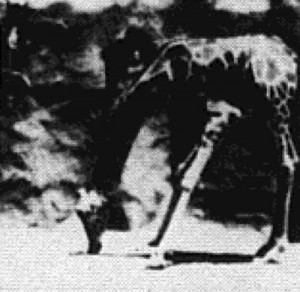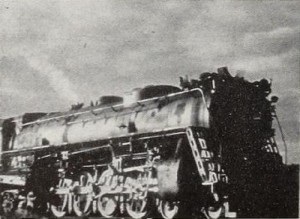
"The life cycle of the peach -- from peach blossom to peach pie" (Holmes, 2018).
"Pioneers' Progess begins with the land rush into Oklahoma territory almost a century ago, then shows the result of this stampede and the progress that Oklahoma has enjoyed in the intervening years" PSA Journal, Sept. 1966, 35.
"Plato in Amerika deals with the new life a young fellow from the Old Country finds in America. From working as a waiter in a restaurant to shooting dice with his friends, we see him dancing, brawling, wenching, and embarrassing his parents. When at last he is forced to marry one of his girl friends and later is seen romping with his children, he smiles at the camera and decides "this is life" PSA Journal, Sept. 1965, 51.

"Bituminous coal is the major actor in The Power Behind the Nation. This sound on film color movie, made by Waldo E. Austin for the Norfolk and Western Railway Company, shows effectively the tremendous part played by soft coal in the development of the nation. The picture is well filmed and thoroughly integrated by an excellent narrative, while lead and end titles are appropriately double exposed on shots of moving trains, which serve to drive home the point that the railroad is the important link between the mine and the consumer. Exceedingly fine sequences of coal mining and well handled shots of the railroad equipment are high points. This film is a fine example of an industrial motion picture produced without the excessive equipment and appropriations sometimes thought to be necessary for such an effort. " Movie Makers, Dec. 1940, 604.

"As part of the general program of heart research, studies are being made to determine how the body's blood pressure can compensate for sudden and extreme differences in elevation. At the San Diego Zoo, the long-necked animals - the giraffe, the horse and the llama - are used in this research project. By surgical procedure, devices are inserted in the animal's body which measure and record the external actions and the internal natural control mechanism of the heart. The information compiled from these studies will aid greatly in man's effort to understand the complexities of the body" PSA Journal, Oct. 1963, 41.

"Railroads Speed the Freights, filmed by T. W. Willard, is a compact industrial picture that presents its story with the maximum of effectiveness. The technique of operating our country's vast railway freight system is clearly summarized; the audience learns the methods employed in sorting, loading and routing freight cars and, in the process, sees some especially handsome movies of railroading. Particularly impressive are the dissolves from the shot of one moving freight train to another. Mr. Willard carefully studied the relationship of motion in the successive scenes and produced a sequence of dissolves, unmatched in cinematic effect. The series is climaxed by a scene of one train passing through the picture, which dissolves to a shot of another train racing almost head on toward the audience. The outstanding quality of this picture is its completeness and suavity, achieved with a minimum of footage and the smallest practical unit print charge." Movie Makers, Dec. 1942, 507.

"Rainbow Fantasy, in the words of Charles C. Hammack, is "an attempt to produce — not a conventional travelog — but more a story of adventure, a hiking adventure to what is probably one of the least visited of our national monuments, Rainbow Bridge, in southeastern Utah." In achieving this goal, Mr. Hammack has been largely and creditably successful. For him and his young wife, Rainbow Bridge takes on the aura of a lost horizon, a Shangri La protected from the outside world by the blistering desert heat and the brutal desert rocks. He brings this overtone of feeling to his film, both through his imaginative camera treatment of the subject and the intentionally dramatic acting of the two travelers. Mr. Hammack's is a new name in Ten Best competition, but it is one which we believe will be heard again."Movie Makers, Dec. 1943, 478.

"RATAMATA is a portrait of the diverse opinions of Chicagoans (ranging from high school students to habitual mayoral candidate Lars Daly) as they reflect on the general state of affairs in America, the war in Vietnam, social and racial conflict, freedom and personal liberty, happiness, and social justice." Chicago Film Archives

"To love a place so well that you can film it so well that the result becomes commercially sought is not the happy fortune of every movie amateur. Waldo E. Austin's Richmond Under Three Flags was paid for by the Morris Plan Bank of Virginia, in Richmond, and is distributed by the Virginia Conservation Commission. Here, a man of culture and a filmer of exceptional care and refinement has given us his own home, lovingly and interestingly presented, with a happy quota of cinematic ornaments. The pace of this accomplishment is leisurely, as was the Old South, yet its manner is modern, as is the new Richmond. In the title wordings, Mr. Austin is especially fortunate, avoiding banality on the one hand and '"fine writing" on the other, with just enough rhetoric to give the flavor of one of the country's most rhetorical centers. The interior scenes of public buildings have been accomplished with an apparent effortlessness that conceals a great deal of effort. Here is the publicity film in its most suave expression." Movie Makers, Dec. 1937, 627-628.

"Black-and-white home movie provides a tour of Rockefeller Center, including scenes of Mary Pickford and Buddy Rogers at a garden event." oldfilm.org
Total Pages: 23